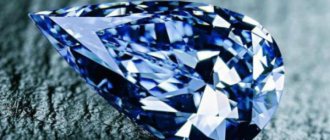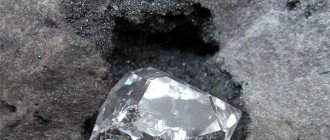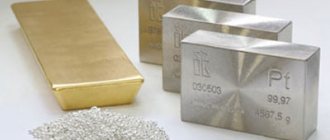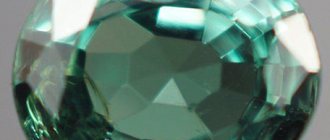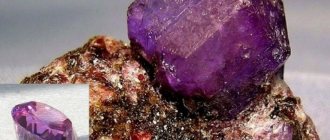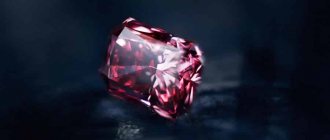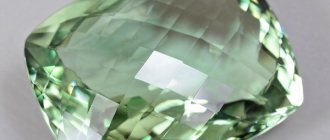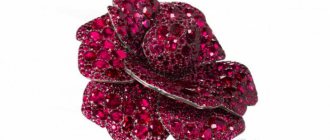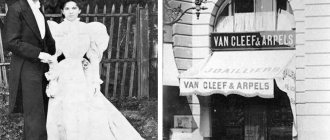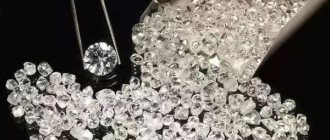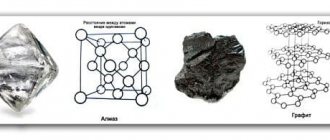#2 – Hydrangea
A peach-colored diamond in the shape of a kite.
The Hydrangea is a 20-carat pale orange-pink diamond that has an almost perfect cut and a very unique shape. Unlike other diamonds on this list, Hydrangea is small in size compared to other world famous diamonds.
Although it may be small in size, Hydrangea makes our list because of its rich history and attractive light pink hue. This diamond was named after the Queen of Holland, who was also the stepdaughter of the French Emperor Napoleon Bonaparte.
It is currently on display in the Louvre Museum in Paris and is part of the French Crown Jewels.
What is the further fate of the pebble?
For more than 500 years, the famous decoration was part of the royal treasury of England. The further fate of the diamond is connected with the following historical events:
- When a coup occurred in England, the Stuart dynasty lost its power. It was decided to sell the product to Cardinal Mazarin. The sale price is considered to be 25 thousand pounds. After his death, it was bequeathed to Louis 14 and his family.
- The Great French Revolution again changed the location of the jewel. As a result of the robbery, the royal family lost many things that had been their possession for many years. Among the stolen items from the royal treasury was Sancy.
- Until 1828, nothing was known about the decoration, until it was put up for sale and bought by Pavel Demidov. So the decoration became part of Russian history. For what reason the Demidovs decided to resell the product in 1865 remains only a guess. But so the Indian Raj became its new owner, who sold the purchase to an unknown person a year later.
- The World Exhibition in Paris in 1867 became famous for the presence of a magnificent piece of light yellow color. Experts estimated the cost of the decoration at that time at a million francs. After the exhibition, the diamond disappeared from view for 40 years.
- It is unknown how the stone got into the Astor family collection, but it happened in 1906. For more than 70 years, members of the Astor family carefully passed on the jewel, but it would eventually be sold to the Louvre by the fourth Lord Astor.
History of stone and Russia
When Pavel Demidov became the owner of the jewelry, Russia’s connection with the history of this wonderful stone began. According to legend, it was given by Demidov to his beloved Aurora Shernval. She loved to be in solitude in her villa in Helsingrfors (modern Helsinki). The name of this girl was already associated with a sad curse. All her suitors died before the wedding.
This reputation greatly frightened Pavel Demidov’s friends, who dissuaded him from even approaching this girl. But he was not one of those who believed in curses. He was not even frightened by the story that the Sansi diamond had previously been owned by Arab kings, and it was an adornment of one of the Indian gods in the temple. The entrepreneurial spirit and fearlessness helped Mr. Demidov get both the jewel and the beautiful wife.
#4 – Taylor-Burton
Fairytale romance in this stunning pear diamond.
Taylor-Burton is a newcomer to the world of famous diamonds. Recently discovered in 1966, this gemstone weighs 69 carats and is the largest piece of the amazing 240 carat rough diamond.
As the name suggests, this diamond has a direct connection to one of the most famous and high-profile romances of the 20th century - the relationship between Richard Burton and Elizabeth Taylor. Richard Burton bought this diamond out of love and framed it as a gift.
After Richard Burton's death in 1979, Liz Taylor sold the diamond for $2.8 million (original price was $1.1 million) and donated a significant portion of the proceeds to charity in memory of her husband.
Types of diamonds: are they so precious?
Stones are also differentiated by area of application. They are divided into:
- Jewelry (minerals that can be processed and cut, without visible defects);
- Technical (stones with many inclusions, damaged texture, unsuitable for making jewelry).
Diamonds for technical use, in turn, have several names:
- bead (fragments of crystals with cracks and inclusions that cannot be cut. They are usually used to make abrasive powder);
- ballas (round stones with a dark shell, usually do not contain inclusions);
- carbonado (the most popular and sought-after stone among technical stones. It is quite dense and resistant to abrasion, which means it is suitable for the production of drilling and grinding equipment, diamond discs and other spare parts for cutting, grinding, polishing. Due to the high carbon content, it has a pronounced black color .
Let it be known to you that the lion's share of all diamonds mined and used in the world are industrial diamonds. Only about 20% is left for jewelry. This is not at all due to the lack of demand for precious stones, but to the fact that they are much more difficult to extract. For every 1 million minerals, there is only 1 that is worthy of the attention of jewelers, weighing about a carat. Imagine how many tons of ore you sometimes have to shovel in order to get the coveted stone!
And then it takes a lot of time and effort from craftsmen to hone it to perfection. Only cutting helps the stone shine in the full sense of the word, although during processing the mineral suffers considerable losses, namely about 50% of the original mass turns into chips and waste.
#3 – Koh-i-Noor
Notice the large cage and slightly asymmetrical cut?
Koh-i-Noor, or the Mountain of Light, is probably the stone that most people have heard of. An interesting fact is that people recognize a diamond not by its appearance, but by its name. The reason for this strangeness, in my opinion, is grotesque.
In the late 18th century, Joseph Hardtmuth founded the Koh-i-Noor Hardtmuth pencil company, which he named after the famous diamond. Interestingly, the company is still in business and produces thousands of pencils every day.
Although graphite is another form of carbon, it is not nearly as priceless as diamonds. Isn't it ironic that the history of one of the brightest diamonds is so closely connected with pencils?
Anyway, Koh-i-Noor is an oval-cut stone weighing 105 carats. Its long and rich history depicts epic tales of ever-changing ownership that began in India in the early 14th century. Today the diamond is a member of the British Crown Jewels and is kept in the Tower of London.
The most expensive diamonds and diamonds
Famous diamonds are more expensive than rough diamonds. The price depends on the quality of the cut, shape, and fame of the jeweler. Additionally, read about the most expensive stones in the world.
Sancy
The first description of a diamond dates back to 1570. It was acquired by the French ambassador de Sancy from the Turks. The unusual specimen got its name from the owner's name. Was bought by the Louvre for a million francs. Today it is considered priceless.
View this post on Instagram
Posted by Ekaterina (@blazetti) Sep 24, 2021 at 2:00 PDT
Koh-i-noor
The name of the famous stone “Kohinoor” is translated as “mountain of light”. The first description dates back to 1304, belonged to all the Mughal rulers. All owners suffered an early and cruel death, which is why Kohinoor is called the cursed stone. Initially it weighed 793 carats, after cutting - 105, or 21 grams.
Recognized as a priceless treasure of the Tower.
View this post on Instagram
Posted by GML RAS (@gml_ras) Apr 5, 2021 at 12:45 PDT
Hope
The history of its appearance before cutting is unknown. Its first official owner was King Louis XIV. In 1829 it was acquired by banker Henry Hope. Like “Kohinoor”, it brought death to all its owners. The price is $350 million.
Read more about the history of the stone in the article about the blue diamond.
View this post on Instagram
Publication from the World of Engagement Rings #Oread (@rings_ru) Sep 2, 2016 at 2:05 PDT
Man-made and natural
Of course, there are not enough stones of these rare colors for everyone. That is why people have learned to create diamonds on their own, giving them a perfectly even color and shape.
According to the type of creation, diamonds are divided into:
- Natural. They come to the surface during the eruption of giant volcanoes and sometimes lie at great depths. From a liquid state, upon cooling, they become superhard crystals. It is in this form that geologists find them in kimberlite pipes or placers.
- Artificial (synthesized). Such stones almost completely replicate the structure of real diamonds. Moreover, the process of their production completely replicates the natural one. In special chambers, carbon is first exposed to enormous temperatures and high pressure, and then cooled and processed. These minerals are slightly cheaper than natural ones and are in great demand in the jewelry industry. They do not have foreign inclusions, so ideal color purity is always the prerogative of the “artificial” ones. Natural gems almost always have various impurities.
No. 5 – Big Star of Africa; Cullinan
The Star of Africa or Cullinan I is currently the largest colorless diamond in the world, weighing 530.20 carats. Interestingly, this diamond was cut from a larger piece of diamond that originally weighed 3,106 carats.
Today, the magnificent pear-shaped Star of Africa is part of the British Crown Jewels collection. It is currently mounted on the royal scepter and kept in the Tower of London.
Origin of the largest diamonds in Russia
The largest diamonds found in Russia were mined in Yakutia. Here are the five largest jewelry diamonds:
- “XXVI Congress of the CPSU” weighing almost 343 carats
- "Alexander Pushkin" 321 carats
- “The Creator” weighs about 300 carats
- “Free Russia”, presented to Yeltsin, weighs 242 carats
- "Star of Yakutia" 232 carats
Diamond is rightfully considered the most popular and desirable stone on the planet. This is a real gift from the bowels of the earth. Such a stone requires an attentive and respectful attitude. It is intended for determined and courageous individuals.
World famous diamonds – what are they for?
Minimalists can easily say that they are just symbols of greed and materialism. In my personal opinion, I believe that what they say is not too far from the truth. Let's be honest with ourselves and with the world. No matter how much we try to deny it, most of us are vain to a certain extent.
While these diamonds may reflect the greed and vanity of many people, I would argue that they reflect the amazing complexity and beauty of human destiny.
By the way, you won't need an astronomical budget to buy the legendary ring. Brands like White Flash and Brian Gavin offer fantastic engagement ring designs that will make people go “Wow!”
If you are looking for a beautiful diamond ring, be sure to check it out for yourself!
I hope you found this article interesting. Do you agree with our list of the 5 most famous diamonds in the world? Which diamond do you think deserves to take first place? Leave a comment to let us know!
